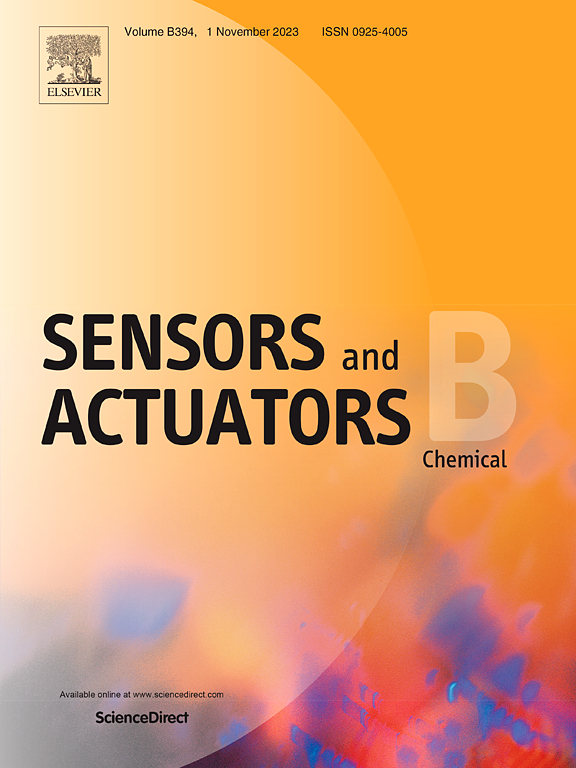无创电化学生物传感器快速检测患者唾液中幽门螺杆菌
IF 3.7
1区 化学
Q1 CHEMISTRY, ANALYTICAL
引用次数: 0
摘要
致癌性细菌幽门螺杆菌感染了全球一半以上的人口,在低收入国家发病率更高。它与慢性胃炎、消化性溃疡和胃癌等疾病有关,而胃癌是全球癌症相关死亡的主要原因。金标准诊断方法包括通过上消化道内窥镜对胃活检组织进行组织病理学评估——这是一个侵入性的、复杂的、耗时的过程,需要专业的专业人员。本研究提出了一种无创替代方法:一种阻抗电化学生物传感器,用于唾液中幽门螺杆菌抗原检测。该生物传感器是用聚吡咯纳米管和羧化多壁碳纳米管修饰的丝网印刷碳电极开发的。利用EDC/NHS化学将靶向幽门螺杆菌细胞毒效应蛋白CagA的单克隆抗体固定在碳纳米管上。通过扫描电镜和电化学技术对平台进行了表征。分析物检测采用电化学阻抗谱法(EIS),在加入CagA蛋白的磷酸盐缓冲盐水(PBS)中构建分析曲线。该生物传感器的线性检测范围为0.5 pg mL - 1 - 3.3 ng mL - 1,检测限为109.9 fg mL - 1。患者唾液样本验证,经组织病理学和快速脲酶检测证实,准确度为97%,灵敏度为80%,特异性为100%。结果在15分钟内得到。这种基于is的生物传感器为早期幽门螺杆菌诊断提供了一个敏感、创新、无创的平台,对预防胃癌等严重疾病至关重要。本文章由计算机程序翻译,如有差异,请以英文原文为准。

Noninvasive electrochemical biosensor for rapid detection of Helicobacter pylori in patient saliva
The carcinogenic bacterium Helicobacter pylori infect over half the global population, with a higher prevalence in low-income countries. It is linked to diseases such as chronic gastritis, peptic ulcers, and gastric cancer, a leading cause of cancer-related deaths worldwide. The gold standard diagnostic method involves histopathological evaluation of gastric biopsy tissue via upper gastrointestinal endoscopy—an invasive, complex, and time-intensive procedure requiring specialized professionals. This study presents a noninvasive alternative: an impedimetric electrochemical biosensor for H. pylori antigen detection in saliva. The biosensor was developed using a screen-printed carbon electrode modified with polypyrrole nanotubes and carboxylated multi-walled carbon nanotubes. Monoclonal antibodies targeting CagA, a cytotoxic effector protein of H. pylori, were immobilized on carbon nanotubes using EDC/NHS chemistry. The platform was characterized via scanning electron microscopy and electrochemical techniques. Electrochemical impedance spectroscopy (EIS) was employed for analyte detection, with an analytical curve constructed in phosphate-buffered saline (PBS) spiked with CagA protein. The biosensor demonstrated a linear detection range of 0.5 pg mL⁻¹ to 3.3 ng mL⁻¹ and a detection limit of 109.9 fg mL⁻¹ . Validation with patient saliva samples, confirmed by histopathology and rapid urease testing, yielded 97 % accuracy, 80 % sensitivity, and 100 % specificity. Results were obtained within 15 min. This EIS-based biosensor offers a sensitive, innovative, and noninvasive platform for early H. pylori diagnosis, which is essential for preventing severe diseases such as gastric cancer.
求助全文
通过发布文献求助,成功后即可免费获取论文全文。
去求助
来源期刊

Sensors and Actuators B: Chemical
工程技术-电化学
CiteScore
14.60
自引率
11.90%
发文量
1776
审稿时长
3.2 months
期刊介绍:
Sensors & Actuators, B: Chemical is an international journal focused on the research and development of chemical transducers. It covers chemical sensors and biosensors, chemical actuators, and analytical microsystems. The journal is interdisciplinary, aiming to publish original works showcasing substantial advancements beyond the current state of the art in these fields, with practical applicability to solving meaningful analytical problems. Review articles are accepted by invitation from an Editor of the journal.
 求助内容:
求助内容: 应助结果提醒方式:
应助结果提醒方式:


